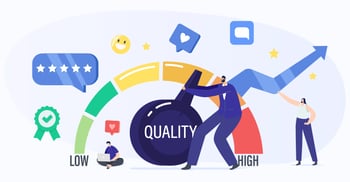CAC Payback Period: The Key to Measuring ROI
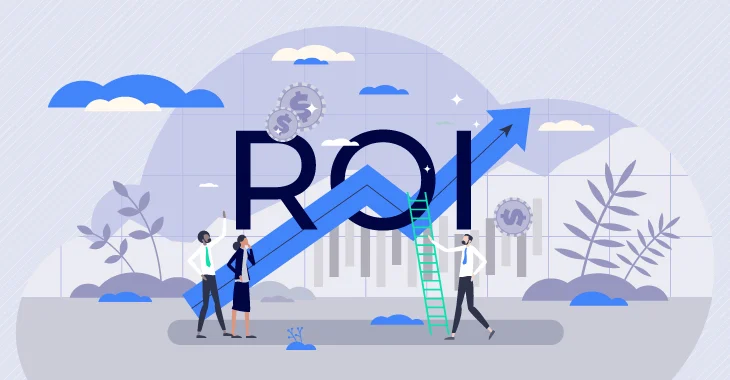
As a software or SaaS business, it's crucial to grasp the perplexing concepts of Customer Acquisition Cost (CAC) Payback Period and the Lifetime Value (LTV): CAC Ratio.
These metrics offer a glimpse into the well-being and efficacy of a business, serving as a basic element in a comprehensive framework that enables corporations to make informed decisions concerning their subscription marketing endeavors, product innovation, user acquisition costs, and SaaS retention tactics. Our guide on how to successfully recover revenue will help you understand what these methods are.
The relationship between these metrics can be pretty technical, and a deeper understanding can greatly enhance the success of your business.
What is a CAC payback?
The notion of CAC reimbursement is centered around determining the duration of time required for a corporation to recover the costs it incurs in acquiring new customers.
The term "CAC" refers to an indicator that quantifies the expenses incurred in securing a fresh client, including the outlays associated with sales and marketing channels aimed at attracting and transforming potential clients.
The CAC reimbursement period calculates the number of months or years needed for the typical customer's revenue or profit to offset the CAC expenses.
Your Dedicated eCommerce Partner.
Thrive with the industry’s most innovative all-in-one SaaS & Digital Goods solution. From high-performing payment and analytics tools to complete tax management, as well as subscription & billing handling, PayPro Global is ready to scale your SaaS.
Sell your SaaS globally with PayPro Global!
This metric is crucial for up-and-coming enterprises and expanding businesses as it offers insights into their customer acquisition approach and whether their investment in acquiring customers is yielding lucrative returns.
A CAC reimbursement period that is shorter in duration indicates a more efficient customer acquisition methodology and a more resilient business model, whereas a prolonged reimbursement period and breakeven point may indicate the need for reevaluating and enhancing the customer acquisition approach.
Who Uses the CAC Payback Period?
The CAC payback period calculation is useful for numerous firm stakeholders:
-
-
Entrepreneurs and founders: The CAC payback period can help entrepreneurs and founders evaluate their customer acquisition approach and discover areas for improvement.
-
-
Investors: Investors use the CAC payback period to determine a company's ROI and growth sustainability. Investors want a shorter AC payback period because it shows that customer acquisition investments are paying off.
-
-
Sales and Marketing Teams: Sales and marketing teams can analyze the efficacy of their customer acquisition activities and prioritize actions to shorten the CAC payback period and increase customer acquisition strategy efficiency.
-
-
C-Suite Executives: CEOs, CFOs, and CMOs use the CAC payback time to analyze company performance, make strategic decisions about customer acquisition efforts, and raise additional capital for growth-driving activities.
-
Financial Analysts: Financial analysts utilize the CAC payback period to evaluate financial performance and offer recommendations in terms of investments or the company's pricing strategy. Analysts prefer a shorter CAC payback period since it demonstrates a strong return on customer acquisition efforts.
The CAC payback period represents one of the key metrics for assessing a company's customer acquisition activities' performance and sustainability.
How to calculate CAC
The computation of this reimbursement period is accomplished via the following CAC payback period formula:
CAC reimbursement period = CAC / (Average revenue per customer)
Where:
CAC = Total expenses incurred in acquiring new customers (sales and marketing expenses)
Average revenue per customer = Total revenue generated by new customers divided by the total number of new customers
For instance, if a company incurs $100,000 in expenses on sales and marketing efforts to secure 100 new customers and the average revenue generated per customer is $500, then the CAC reimbursement period would be:
CAC reimbursement period = $100,000 / ($500 x 100) = $100,000 / $50,000 = 2 years
This implies that the company would require 2 years to recoup its investment of $100,000 in acquiring new customers, given that all other variables remain unchanged.

It is imperative to emphasize that the CAC reimbursement period is merely one metric to gauge the efficiency and effectiveness of the customer acquisition strategy. Whatever result the CAC Payback calculation gives you, be sure to analyze it in conjunction with other SaaS metric benchmarks for lifetime value, churn rate, and customer lifetime revenue to attain a comprehensive understanding. Also, track it periodically to asses new operational costs, if there are any, as well as marketing and sales efficiency.
What is a typical CAC payback period?
A "normal" CAC payback period varies by industry, which is really why there aren’t any actual CAC payback period benchmarks. Technology and pharmaceutical businesses, which have significant client acquisition expenses, may have longer payback periods. E-commerce and consumer items have reduced customer acquisition expenses, so payback periods may be faster.
The growth stage might also affect CAC payback. Early-stage startups may have higher CACs to rapidly acquire customers. Maximizing customer lifetime value may cut CAC and lengthen payback as the company matures.
The CAC payback period varies on the industry, target market, product or service, and client acquisition approach. Companies must assess their CAC payback period and decide based on their conditions.
How does the payback period relate to other SaaS metrics?
For SaaS companies, the CAC payback period is intertwined with various other key SaaS metrics. Comprehending the correlation between these metrics can help in offering a more comprehensive view of a company's performance and customer acquisition strategy.
Here are some of the vital metrics related to the CAC payback period in the SaaS industry:
-
-
Lifetime Value (LTV)
LTV is a metric that determines the total revenue generated by a customer throughout their association with the company. A higher LTV suggests that the customer holds greater value for the business, and a shorter CAC payback period becomes more feasible.
-
-
Churn Rate
Churn rate is the percentage of customers who discontinue using a product or service over a specified time frame. A high number of customer churns can elongate the CAC payback period as it indicates that the SaaS company needs to acquire additional customers to compensate for the loss. -
-
Gross Margin
Gross margin is a metric that measures profitability by determining the revenue remaining after deducting the cost of goods sold. A higher gross margin percentage can help shorten the CAC payback period by enabling the company to invest more in customer acquisition efforts.
-
-
Monthly Recurring Revenue (MRR)
MRR is a metric that measures the recurring revenue generated by a company's customers on a monthly basis. A higher MRR can help shorten the CAC payback period by providing a more stable and predictable stream of revenue. -
Customer Lifetime Revenue (CLR)
CLR is a metric that measures the total revenue generated from a customer throughout their lifetime. A higher CLR can help shorten the CAC payback period by providing a more precise estimate of how much a customer contributes to your business and their value.
By evaluating the CAC payback period in conjunction with these other metrics, companies can obtain a clearer perspective on their customer acquisition strategy and assess their sales and marketing efforts. Additionally, by having a comprehensive view of your strategies, SaaS businesses can work to achieve shorter payback periods and recover acquisition costs.
CAC Payback VS LTV:CAC Ratio: Which Is More Important?
The CAC payback period and the LTV:CAC ratio are critical indicators that offer valuable insights into the performance and growth prospects of a company.
The CAC payback period calculates the duration required to generate revenue from a newly acquired customer that compensates for the costs incurred in acquiring them. A shorter CAC payback period reveals an efficient customer acquisition strategy that generates positive returns on investment.
On the other hand, the LTV:CAC ratio measures the correlation between the lifetime value of a customer and the cost of acquiring them. A higher LTV:CAC ratio signifies that a company is generating more revenue from a customer over time than the cost of acquiring them, representing a positive indication of the company's growth potential.
In conclusion, both metrics are of utmost importance and should be tracked simultaneously. A shorter CAC payback period highlights an efficient customer acquisition process, while a high LTV: CAC ratio demonstrates a robust return on customer acquisition investments in the long run. Tracking both metrics provides a comprehensive understanding of your business growth potential.
Advantages and Disadvantages of CAC Payback
The advantages of understanding the CAC Payback Period are:
-
-
Unlocking the Enigma of Customer Acquisition Efficiency: CAC payback period sheds light on the efficiency with which a company captures new clients. By comprehending the payback period, businesses can pinpoint areas that require improvement in their customer acquisition methodologies and redirect resources with greater purpose.
-
-
Assessing the Profitability of Customer Acquisition Ventures: CAC payback period serves as a means to gauge the Return on Investment (ROI) of customer acquisition endeavors, such as advertising and marketing drives. By being aware of the payback period, companies can make calculated decisions about which endeavors are yielding optimal profits.
-
-
Fostering Data-Informed Strategic Decisions: The CAC payback period is a data-centric metric that presents a straightforward and impartial way to evaluate the efficacy of customer acquisition efforts. This can aid companies in making informed and objective choices regarding their customer acquisition tactics.
-
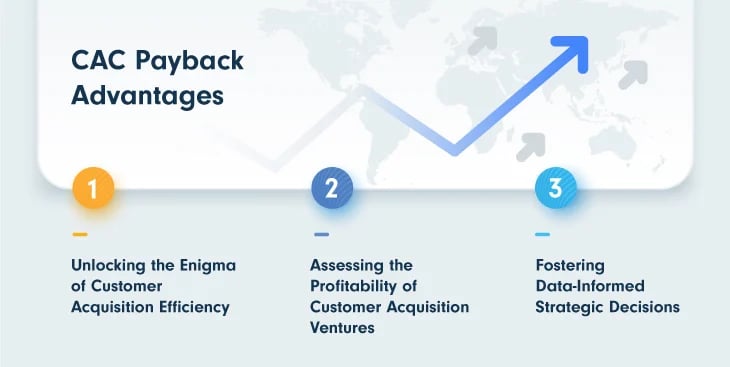
The cons of using the CAC Payback Period are:
-
-
-
Disregards the Importance of Customer Lifetime Value: The CAC payback period overlooks the significance of a customer's lifetime value (LTV), focusing solely on the cost of acquiring the customer. While LTV provides critical information about a customer's long-term potential, the payback period only offers a glimpse of the efficiency of customer acquisition within a specific time period.
-
-
-
-
Inadequate in Capturing the Nuances of Customer Acquisition: Customer acquisition is a multifaceted process, encompassing a range of variables such as market dynamics, competition, and customer behavior. The payback period may fall short in accurately reflecting the intricacies of customer acquisition, as it takes into account only a selective set of variables.
-
-
-
-
Subject to Fluctuations Due to Changes in Customer Conduct: The CAC payback period can be susceptible to fluctuations resulting from shifts in customer behavior, such as an increase in churn, which can negatively fimpact the subscription revenue generated from a customer. This can lead to alterations in the payback period over time, making it challenging to monitor and measure the productivity of customer acquisition endeavors consistently.
-
-
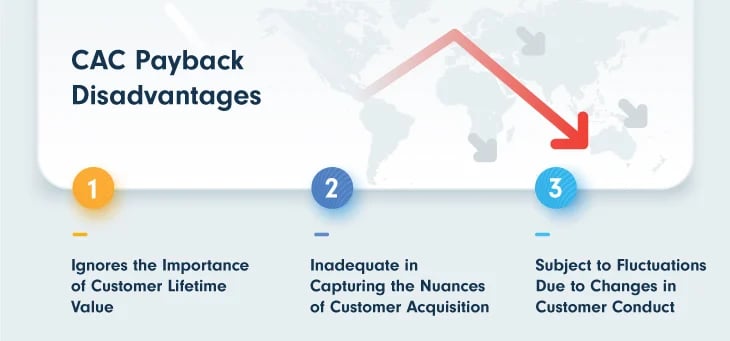
In conclusion, while the CAC payback period offers valuable perspectives on the effectiveness of customer acquisition endeavors, it is crucial to recognize its limitations and use it in conjunction with other metrics, such as customer lifetime value, to gain a comprehensive understanding of a company's customer acquisition approach.
This holistic view can help companies make more informed and effective decisions about their customer acquisition strategies and allocate resources more wisely.
5 Effective Ways to Reduce the Payback Period
To shrink the CAC payback period and foster a more successful customer acquisition approach, companies can take advantage of various optimization techniques:
1. Streamline Marketing Expenditures
Analyze your marketing budget to guarantee that your resources are directed to the channels and methods that generate the greatest return on investment. This may involve redirecting resources from less productive channels to more fruitful ones or investing in technology and tools to automate and simplify marketing activities.
2. Elevate Conversion Rates
Increase the conversion rate from leads to paying customers by streamlining sales and marketing procedures and enhancing the user experience. This may include upgrading the design of your website, simplifying the purchasing process, and investing in sales enablement resources and training.

3. Decrease Customer Attrition
Minimize the number of customers who discontinue using your product or service by enhancing the customer experience, offering better support and customer service, and addressing any pain points or dissatisfaction.
4. Raise Average Revenue per Customer
Boost the average revenue generated per customer by offering premium products and services, cross-selling, or up-selling to existing customers.
5. Prioritize High-Quality Leads
Focus your sales and marketing endeavors on high-quality leads that are more likely to convert to paying customers instead of investing time and resources on low-quality leads.
By implementing these optimization strategies, companies can shorten the CAC payback period and enhance the power of their customer acquisition approach. However, it's crucial to continuously re-evaluate and adjust these strategies as market conditions, customer behavior, and competitive dynamics evolve over time.
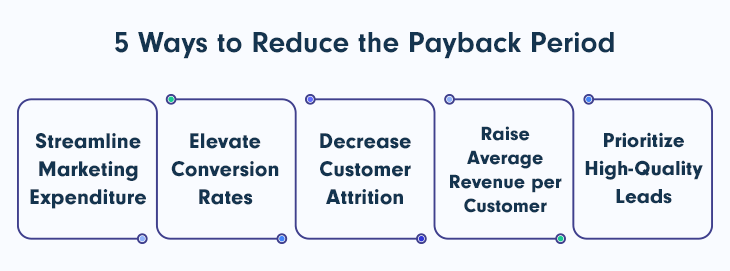
4 Reasons Why the CAC Payback Period is Important
The significance of the Customer Acquisition Cost (CAC) payback period cannot be overstated. It is a critical metric that delivers a plethora of information crucial to the success of a company.
1. The efficiency of Customer Acquisition Unveiled
The CAC payback period acts as a barometer for gauging the proficiency of a company's customer acquisition endeavors. It calculates the amount of time required to generate sufficient revenue from a newly acquired customer to compensate for the costs incurred in acquiring them. A shorter CAC payback period is a testament to the efficiency of the customer acquisition efforts and manifests a positive return on investment.
2. Sustainability of Growth Evaluated
The CAC payback period acts as a litmus test for evaluating the viability of a company's growth trajectory. It provides a measure of the efficiency of customer acquisition efforts and the impact of acquisition costs on the company's overall profitability. A prolonged CAC payback period may indicate that a company is incurring more costs in customer acquisition than the revenue generated, which could be detrimental to the long-term sustainability of the company.
3. Prioritizing Customer Acquisition Costs
The CAC payback period serves as a roadmap for prioritizing customer acquisition investments. It sheds light on the most productive customer acquisition initiatives and offers opportunities to reduce the CAC payback period, thereby improving the cost-effectiveness of the customer acquisition strategy.
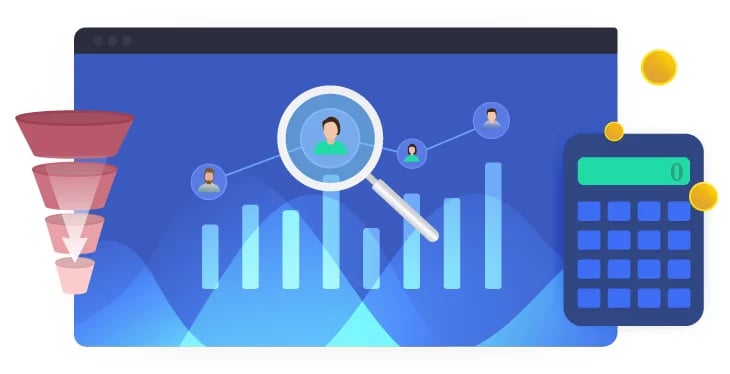
4. Decision-Making Aided
The CAC payback period is a powerful tool that supports decision-making. It provides a clear picture of the financial performance of a company and enables executives to make informed decisions regarding customer acquisition investments, pricing, marketing, sales initiatives, and resource allocation. Speaking of product monetization, be sure to check our SaaS pricing guide to get a sense of all the strategies and techniques you can employ.
In conclusion, the CAC payback period is a crucial performance metric that provides valuable insight into the proficiency of a company's customer acquisition efforts. It is imperative for evaluating the sustainability of growth, making informed investment decisions, and supporting overall decision-making.
4 Payback Period Calculating Challenges & Solutions
The calculation of the CAC payback period can be plagued by several perils if proper measures are not taken to mitigate these problems. A few examples of such pitfalls are:
1. Misconstrued Conceptualization of CAC
Miscalculating the cost of customer acquisition (CAC) can result in an erroneous payback period computation. Overestimating or ignoring certain costs, such as overhead, technology, and employee salaries, while only factoring in your direct costs as advertising and sales commissions, can result in a distorted CAC calculation.
2. Neglecting Customer Attrition
Customer churn has a significant effect on the payback period calculation, as lost customers won't contribute to the revenue that is used to recover the CAC. Thus, it is imperative for companies to consider customer churn when computing the payback period to get a more realistic picture of their customer acquisition efficiency.
3. Undervaluing LTV
Underestimating the lifetime value (LTV) of a customer can lead to a misleadingly optimistic payback period computation. Accurately assessing the LTV of their customers is crucial for companies to accurately compute the payback period.
4. Disregard of Timing for Revenue and Costs
The timing of revenue and costs can significantly affect the payback period computation. For instance, if a company incurs considerable customer acquisition costs in the initial month but revenue isn't generated until later, the payback period would seem longer than it actually is.

To avoid these difficulties, companies can undertake the following measures:
1. Precise Definition of CAC
To guarantee accurate payback period computation, companies need to have a clear and all-encompassing definition of CAC that encompasses both direct and indirect costs.
2. Incorporation of Customer Churn
Companies need to consider customer churn while computing the payback period to have a more realistic understanding of their customer acquisition capabilities.
3. Accurate Estimation of LTV
Companies should have a sensible assessment of their customer's LTV to accurately compute the payback period.
4. Timing Consideration for Revenue and Costs
Companies should keep in mind the timing of revenue and costs while computing the payback period and make necessary modifications to their calculations accordingly.
By taking these proactive steps, companies can overcome the difficulties in calculating the CAC payback period and attain a more accurate understanding of how effective their customer acquisition is.
Your Dedicated eCommerce Partner.
Thrive with the industry’s most innovative all-in-one SaaS & Digital Goods solution. From high-performing payment and analytics tools to complete tax management, as well as subscription & billing handling, PayPro Global is ready to scale your SaaS.
Sell your SaaS globally with PayPro Global!
How Can PayPro Global Help?
PayPro Global is a complete eCommerce solution built to help software, SaaS, and digital goods developers scale their business worldwide in record time. We offer a wide range of growth tools, including strong reporting systems capable of providing real-time data.
This is particularly beneficial, as SaaS developers can check and modify their marketing approach based on the insights obtained. You may check the effectiveness of your ongoing campaigns and make necessary adjustments to get the best outcomes in terms of revenue generated. Additionally, you can design customized growth strategies and better manage operational costs using historical data, ensuring better sales in new areas.
Final Thoughts
For high-performing SaaS companies and not only, it's crucial to determine the effectiveness and long-term viability of their marketing strategy through the LTV: CAC Ratio and CAC Payback Period. Working with eCommerce partners that allow you to analyze your business data will help you in this regard.
Your sales and marketing team can make sure they are successfully acquiring and retaining consumers as well as making wise investments in their customer acquisition operations by routinely evaluating these metrics and making modifications as necessary. They will be prepared for long-term success and steady revenue growth as a result of this.
FAQ
Can the payback period be used to compare investments?
Despite its simplicity, the payback time only assesses an investment's short-term return. Thus, it is not a comprehensive measure of profitability and may even be misleading.
The payback period alone does not show an investment's financial value. The investment's reduced risk or greater anticipated lifetime value may offset its longer payback period, making it a better long-term choice. Therefore, integrate the payback period alongside other financial measures like discounted cash flow analysis or net present value to make smart investment selections.
The payback period can help you compare investments, but you should also consider risk, projected lifetime value, and other aspects before making a decision. A well-informed investment selection may require more than just the payback period.
What are some payback period restrictions?
The payback period, despite its straightforward calculation, is plagued by a number of drawbacks and limitations. Firstly, it fails to account for the risk associated with an investment, rendering it an inadequate measure of investment riskiness. Additionally, the payback period provides no insight into the expected rate of return or the overall profitability of the investment beyond the payback period.
Moreover, the impact of inflation, which can significantly reduce the purchasing power of future cash flows, is not considered in the payback period calculation. This could result in an underestimation of the true financial worth of the investment. Furthermore, the payback period may not be suitable for comparing investments that have different life spans or investments that generate uneven cash flows over time, making it a somewhat unreliable metric for investment comparisons.
In conclusion, the payback period, although a simple and straightforward measure, is limited in its scope and capabilities. To gain a more comprehensive understanding of the potential return on investment, it is advisable to use the payback period in conjunction with other financial metrics such as net present value or internal rate of return. The integration of multiple financial measures will provide a more nuanced and well-rounded evaluation of the investment's financial viability.
What’s a good CAC Payback Period?
Technology industries are very competitive and innovative. A faster payback period helps organizations get a return on investment faster and stay ahead of the competition.
Real estate investments are safer and deliver a steady return over time. In such instances, the investment's consistency and durability may be more significant than its payback period.
Good payback periods are under three years. A payback term of 3 to 5 years is normally sufficient, but a longer duration may require extra investigation. These are general suggestions; the best payback period depends on the company's circumstances and priorities. The company's financial goals, investment strategy, and risk tolerance determine the payback period.
Meir Amzallag
Meir Amzallag is the CEO and Co-Founder of PayPro Global, a leading e-commerce solutions provider for software, SaaS, and digital goods businesses. He is also the Co-Founder of Hocoos, the AI-powered website builder. As a thought leader in online commerce, he offers valuable insights and expertise through his writing, focusing on online payment processing, global tax compliance, subscription management, and the evolving landscape of AI-driven web development. Outside of his professional endeavors, he enjoys spending quality time with his family and pursuing his passion for photography.
-
1.Explore PayPro Global's Solutions: See how our platform can help you streamline your payment processing and boost revenue.
-
2.Get a Free Consultation: Discuss your specific needs with our experts and discover how we can tailor a solution for you.
-
3.Download our Free Resources: Access valuable guides, checklists, and templates to optimize your online sales.
-
4.Become a Partner: Expand your business by offering PayPro Global's solutions to your clients.
Get the latest news

